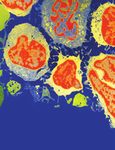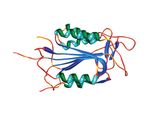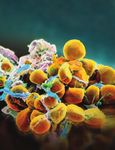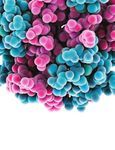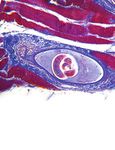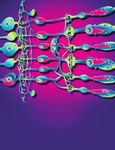Case Report Acute Agitation as an Initial Manifestation of Neuro-Behçet's Disease
←
→
Page content transcription
If your browser does not render page correctly, please read the page content below
Hindawi Case Reports in Emergency Medicine Volume 2018, Article ID 5437027, 3 pages https://doi.org/10.1155/2018/5437027 Case Report Acute Agitation as an Initial Manifestation of Neuro-Behçet’s Disease Yuki Otsuka,1,2 Tetsuya Yumoto ,1 Hiromi Ihoriya,1 Namiko Matsumoto,3 Kota Sato,3 Koji Abe,3 Hiromichi Naito,1 and Atsunori Nakao1 1 Department of Emergency and Critical Care and Disaster Medicine, Okayama University Graduate School of Medicine, Dentistry and Pharmaceutical Sciences, Japan 2 Center for Graduate Medical Education, Okayama University Hospital, Japan 3 Department of Neurology, Graduate School of Medicine, Dentistry and Pharmacy, Okayama University, Japan Correspondence should be addressed to Tetsuya Yumoto; tyumoto@cc.okayama-u.ac.jp Received 28 June 2018; Accepted 21 October 2018; Published 29 November 2018 Academic Editor: Aristomenis Exadaktylos Copyright © 2018 Yuki Otsuka et al. This is an open access article distributed under the Creative Commons Attribution License, which permits unrestricted use, distribution, and reproduction in any medium, provided the original work is properly cited. Managing acutely agitated or violent patients in the emergency department (ED) represents a significant challenge. Acute agitation as an initial manifestation of neuro-Behcet’s disease (NBD) is an extremely rare clinical entity. A 44-year-old male, who had been complaining about a severe headache and fever for several days, was admitted to our ED due to acutely presented incontinence and agitation. On admission, physical restraint and sedation with sevoflurane and propofol were required for his combative and violent behavior. Cerebrospinal fluid examination revealed increased cell count. Fluid attenuated inversion recovery magnetic resonance imaging showed a high intensity signal in the left parietal lobe and bilateral occipital lobe. As infectious meningoencephalitis was suspected, empirical therapy was immediately started. He recovered uneventfully without neurological defect in seven days. Based on positive human leukocyte antigen B-51 and clinical manifestations, the diagnosis of NBD was made and remitted by steroid therapy. Although acute NBD commonly presents with focal neurological symptoms, psychiatric symptoms could be considered the first manifestation. A focused and thorough examination coupled with appropriate management strategies can assist emergency clinicians safely and effectively manage these patients. 1. Introduction disease is a chronic, vasculitic, multisystem syndrome con- sisting of recurrent painful oral and genital ulcers and relaps- Acute agitation, a common but difficult condition encoun- ing uveitis. About 5% of adult patients experience neurologic tered in the emergency department (ED), has a very broad symptoms at the onset of Behçet’s disease [2, 3]. range of differential diagnoses that include neurologic, meta- To the best of our knowledge, acute psychotic attack is bolic, toxicologic, psychiatric, and infectious causes [1]. extremely rare as an initial symptom of NBD and only a few Therefore, emergency physicians need to rapidly and appro- reports have documented acute psychiatric episodes associ- priately assess and manage patients with this condition, as ated with NBD [4, 5]. Although NBD frequently presents with the missing of signs of acute agitation may result in a poor focal neurological signs, psychiatric manifestations could be prognosis. considered the first symptoms of the disease. With this report, The present case report aims to describe the signs, we hope to raise awareness among emergency physicians of symptoms, differential diagnosis, treatment, and course of a the importance of assessing agitation and that agitation may 44-year-old male patient with neuro-Behçet’s disease (NBD) occur as the first manifestation of autoimmune disorders, presenting acute agitation as an initial manifestation. Behçet’s including NBD.
2 Case Reports in Emergency Medicine (a) (b) Figure 1: Circled region showing increased T2 signal of sulci on fluid attenuated inversion recovery sequence involving the left parietal lobe (a) and bilateral occipital lobe (b). 2. Case Presentation neurological defect. The erythema was pathologically proved as erythema nodosum. The patient thereafter reported that A 44-year-old previously healthy male was taken to our ED by he had been experiencing recurrent episodes of oral ulcers ambulance with acute agitation and fever. He had no family throughout the last 20 years. Based on the findings including or personal history of psychiatric issues or psychosocial positive human leucocyte antigen (HLA) B-51, clinical man- stressors that could have caused a psychotic episode. His ifestations, and the effectiveness of methylprednisolone, the family explained that he had been complaining for three days diagnosis of NBD was made and remitted by maintenance of about a severe headache and fever and had acutely presented steroid therapy. incontinence, agitation, and violent behavior two hours prior to the visit. 3. Discussion On admission, the patient displayed bizarre, incorpora- tive and violent behavior against medical staff. Since non- Adult NBD happens more in males than in females and physical strategies against agitated behavior referred to as commonly between 20 and 40 years of age. Although “verbal deescalation” were unsuccessful, we required imme- there are no validated criteria that can be referenced to diate action to protect the patient as well as medical staff diagnose NBD, involvement of the central nervous system from imminent harm using deep sedation. The Richmond (CNS) is categorized into parenchymal and nonparenchymal Agitation Sedation Scale was graded as +4. Physical restraint classifications [2]. While the parenchymal type is caused and administration of sevoflurane and propofol allowed for by primary parenchymal neural lesions typically presenting further assessment assuring the safety of the patient and meningoencephalitis, the nonparenchymal type concentrates medical staff. His vital signs were remarkable for an isolated on the main CNS vascular structures, typically presenting fever of 37.8∘ C associated with Kernig’s sign. The patient did with symptoms and signs attributable to cerebral venous not have oral or genital ulcerations or an erythematous rash. thrombosis [3]. NBD can be acute or chronic based on its His blood test results showed elevated white blood cell count differential clinical course. of 16,990/ L with 80.1% neutrophils and C-reactive protein Some patients with NBD present with both neurolog- of 19.05 mg/dl. Blood gas analysis showed metabolic acidosis ical and psychiatric symptoms characterized by paranoid with a pH of 7.306, base excess -6.5 mmol/L, and lactate attitudes, euphoria, loss of insight/disinhibition, and bipolar 7.5 mmol/L. Toxicological screening was negative. Cere- disorders. Depression, anxiety, and somatization are the most brospinal fluid examination revealed an increased cell count frequently reported manifestations [6]. Such a state was with monocyte dominance (126/uL). Computed tomogra- recently named Neuro-Psycho-Behçet or Neuropsychiatric phy scan of the head was unremarkable. Fluid attenuated Behçet disease [7]. Although the pathogenetic cause behind inversion recovery magnetic resonance imaging showed a Neuro-Psycho-Behçet disease has not been resolved, it may high intensity signal in the sulci of the left parietal lobe and be secondary to the involvement of organic neurological bilateral occipital lobe (Figures 1(a) and 1(b)). As infectious factors or associated with poor quality of life and the meningoencephalitis was suspected, empirical therapy was relapsing/preceding reactivation course of the condition. immediately started with meropenem, vancomycin, acy- Agitation is a frequent presentation in the ED; up to 50% clovir, methyl-prednisolone, and immunoglobulin. of clinicians are victims of violence during their careers [8]. After erythema of the lower leg was noted on day 2, Patients with prominent psychiatric symptoms may present the patient recovered in seven days uneventfully without to psychiatric services during the first instance. However,
Case Reports in Emergency Medicine 3 agitation should be assessed rapidly and managed correctly, References since missing a diagnosis of a dangerous etiology may result in severe mortality and morbidity. [1] M. Gottlieb, B. Long, and A. Koyfman, “Approach to the agitated emergency department patient,” The Journal of Emergency A chief goal to treat agitated patient is to protect the Medicine, vol. 54, pp. 447–457, 2018. patient as well as other patients or medical staff in the area [9]. Verbal deescalation and/or medication are used to [2] A. Siva, A. Altintas, and S. Saip, “Behçet’s syndrome and the nervous system,” Current Opinion in Neurology, vol. 17, no. 3, avoid dangerous situations in an attempt to reduce restraints pp. 347–357, 2004. [9], which have been shown to be associated with longer [3] A. Al-Araji and D. P. Kidd, “Neuro-Behçet’s disease: epidemi- hospital stays [10]. In the present case, verbal deescalation ology, clinical characteristics, and management,” The Lancet strategies were unsuccessful and deep sedative medications Neurology, vol. 8, no. 2, pp. 192–204, 2009. were applied to secure safety of the patient and medical staff, [4] O. Deniz, A. Çayköylü, G. Vural et al., “A case study of Neuro- otherwise escalating to physical confrontation or resulting psycho-Behçet’s Syndrome presenting with psychotic attack,” in delay in diagnosis and further management. Once the Clinical Neurology and Neurosurgery, vol. 111, no. 10, pp. 877– patient is calmed or sedated, obtaining vital signs and a 879, 2009. detailed physical examination are important. In patients older [5] P. Patel, M. Steinschneider, A. Boneparth, and G. Lantos, than 40, new psychiatric symptoms are more inclined to “Neuro-Behçet disease presenting with acute psychosis in an have an organic than a psychiatric cause [11]. NBD should adolescent,” Journal of Child Neurology, vol. 29, no. 9, pp. NP86– be considered a possible diagnosis in patients presenting NP91, 2014. with encephalitis of unknown origin, seizures, psychiatric [6] R. Monastero, C. Camarda, C. Pipia et al., “Cognitive impair- symptoms, psychosis, or movement disorders. Clinicians ment in Behçet’s disease patients without overt neurological should make a diagnosis as fast as possible to ensure well- involvement,” Journal of the Neurological Sciences, vol. 220, no. timed treatment. 1-2, pp. 99–104, 2004. At his initial presentation, our patient did not meet [7] D. Kirbaş, “Neuro-psycho-behçet or neuropsychiatric behçet International Study Group criteria for the diagnosis of disease: A modified name for an old disease,” Noropsikiyatri Behçet’s disease because he lacked skin and ocular lesions Arsivi, vol. 54, no. 3, p. 195, 2017. and genital/oral ulcers and had a negative pathergy test [12]. [8] K. S. Al-Sahlawi, M. A. Zahid, A. A. Shahid, M. Hatim, and Therefore, we did not initially strongly suspect NBD. M. Al-Bader, “Violence against doctors: 1. A study of violence The differential diagnosis of acute agitation with or against doctors in accident and emergency departments,” Euro- without fever includes infectious diseases (i.e., sepsis and pean Journal of Emergency Medicine: Official Journal of the Euro- bacterial, viral, fungal, or tuberculous meningitis), neuro- pean Society for Emergency Medicine, vol. 6, no. 4, pp. 301–304, 1999. logic (i.e., encephalopathy associated with collagen vascular disease or Hashimoto’s thyroiditis, autoimmune encephalitis, [9] J. S. Richmond, J. S. Berlin, A. B. Fishkind et al., “Verbal de-escalation of the agitated patient: Consensus statement of and paraneoplastic encephalitis), metabolic disorders (i.e., the American Association for emergency psychiatry project hypo/hyperglycemia, uremia, electrolyte disorders, or thi- BETA De-escalation workgroup,” Western Journal of Emergency amine deficiency), substance intoxication/withdrawal, and Medicine, vol. 13, no. 1, pp. 17–25, 2012. psychiatric etiologies [1, 13]. In our patient, the combination [10] M. Knutzen, N. H. Mjosund, G. Eidhammer et al., “Character- of positive findings of HLA B-51, repetitive history of oral istics of psychiatric inpatients who experienced restraint and ulcers, emergence of erythema nodosum, and the effective- those who did not: a case-control study,” Psychiatric Services, ness of steroid therapy raised the definitive diagnosis of NBD. vol. 62, no. 5, pp. 492–497, 2011. For patients with an acute psychiatric attack, suspecting [11] B. Good, R. M. Walsh, G. Alexander, and G. Moore, “Assessment an autoimmune mechanism and starting empirical therapy of the acute psychiatric patient in the emergency depart- for meningitis may be critical in helping with the diagnosis ment: Legal cases and caveats,” Western Journal of Emergency of NBD. No matter how rapidly management is needed, Medicine, vol. 15, no. 3, pp. 312–317, 2014. emergency physicians need to calmly and carefully assess the [12] International Study Group for Behçet’s Disease, “Criteria for patient. Importantly, we should be aware that initial recovery diagnosis of Behçet’s disease,” The Lancet, vol. 335, no. 8697, pp. from NBD is frequent, but severe impairment also occurs due 1078–1080, 1990. to relapse. Therefore, careful outpatient follow-up is needed. [13] F. Graus, M. J. Titulaer, and R. Balu, “A clinical approach to diagnosis of autoimmune encephalitis,” The Lancet Neurology, 4. Conclusion vol. 15, no. 4, pp. 391–404, 2016. We reported a case of NBD presenting with acute agitation. Altered mental status may be an initial manifestation of acute NBD. A thorough and detailed exam and appropriate treat- ment strategies with immediate sedation can help emergency clinicians safely and effectively manage these patients. Conflicts of Interest The authors have no conflicts of interest.
MEDIATORS of INFLAMMATION The Scientific Gastroenterology Journal of World Journal Hindawi Publishing Corporation Research and Practice Hindawi Hindawi Diabetes Research Hindawi Disease Markers Hindawi www.hindawi.com Volume 2018 http://www.hindawi.com www.hindawi.com Volume 2018 2013 www.hindawi.com Volume 2018 www.hindawi.com Volume 2018 www.hindawi.com Volume 2018 Journal of International Journal of Immunology Research Hindawi Endocrinology Hindawi www.hindawi.com Volume 2018 www.hindawi.com Volume 2018 Submit your manuscripts at www.hindawi.com BioMed PPAR Research Hindawi Research International Hindawi www.hindawi.com Volume 2018 www.hindawi.com Volume 2018 Journal of Obesity Evidence-Based Journal of Stem Cells Complementary and Journal of Ophthalmology Hindawi International Hindawi Alternative Medicine Hindawi Hindawi Oncology Hindawi www.hindawi.com Volume 2018 www.hindawi.com Volume 2018 www.hindawi.com Volume 2018 www.hindawi.com Volume 2018 www.hindawi.com Volume 2013 Parkinson’s Disease Computational and Mathematical Methods in Medicine Behavioural Neurology AIDS Research and Treatment Oxidative Medicine and Cellular Longevity Hindawi Hindawi Hindawi Hindawi Hindawi www.hindawi.com Volume 2018 www.hindawi.com Volume 2018 www.hindawi.com Volume 2018 www.hindawi.com Volume 2018 www.hindawi.com Volume 2018
You can also read




